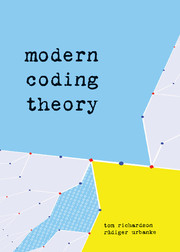Book contents
- Frontmatter
- Contents
- PREFACE
- 1 INTRODUCTION
- 2 FACTOR GRAPHS
- 3 BINARY ERASURE CHANNEL
- 4 BINARY MEMORYLESS SYMMETRIC CHANNELS
- 5 GENERAL CHANNELS
- 6 TURBO CODES
- 7 GENERAL ENSEMBLES
- 8 EXPANDER CODES AND FLIPPING ALGORITHM
- A ENCODING LOW-DENSITY PARITY-CHECK CODES
- B EFFICIENT IMPLEMENTATION OF DENSITY EVOLUTION
- C CONCENTRATION INEQUALITIES
- D FORMAL POWER SUMS
- E CONVEXITY, DEGRADATION, AND STABILITY
- Authors
- Index
3 - BINARY ERASURE CHANNEL
Published online by Cambridge University Press: 05 September 2012
- Frontmatter
- Contents
- PREFACE
- 1 INTRODUCTION
- 2 FACTOR GRAPHS
- 3 BINARY ERASURE CHANNEL
- 4 BINARY MEMORYLESS SYMMETRIC CHANNELS
- 5 GENERAL CHANNELS
- 6 TURBO CODES
- 7 GENERAL ENSEMBLES
- 8 EXPANDER CODES AND FLIPPING ALGORITHM
- A ENCODING LOW-DENSITY PARITY-CHECK CODES
- B EFFICIENT IMPLEMENTATION OF DENSITY EVOLUTION
- C CONCENTRATION INEQUALITIES
- D FORMAL POWER SUMS
- E CONVEXITY, DEGRADATION, AND STABILITY
- Authors
- Index
Summary
The binary erasure channel (BEC) is perhaps the simplest non-trivial channel model imaginable. It was introduced by Elias as a toy example in 1954. The emergence of the Internet promoted the erasure channel into the class of “real-world” channels. Indeed, erasure channels can be used to model data networks, where packets either arrive correctly or are lost due to buffer overflows or excessive delays.
A priori, one might well doubt that studying the BEC will significantly advance our understanding of the general case. Quite surprisingly, however, most properties and statements that we encounter in our investigation of the BEC hold in much greater generality. Thus, the effort invested in fully understanding the BEC case will reap substantial dividends later on.
You do not need to read the whole chapter to know what iterative decoding for the BEC is about. The core of the material is contained in Sections 3.1–3.14 as well as 3.24. The remaining sections concern either more specialized or less accessible topics. They can be read in almost any order.
CHANNEL MODEL
Erasure channels model situations where information may be lost but is never corrupted. The BEC captures erasure in the simplest form: single bits are transmitted and either received correctly or known to be lost. The decoding problem is to find the values of the bits given the locations of the erasures and the non-erased part of the codeword. Figure 3.1 depicts the BEC(∊).
- Type
- Chapter
- Information
- Modern Coding Theory , pp. 71 - 174Publisher: Cambridge University PressPrint publication year: 2008



